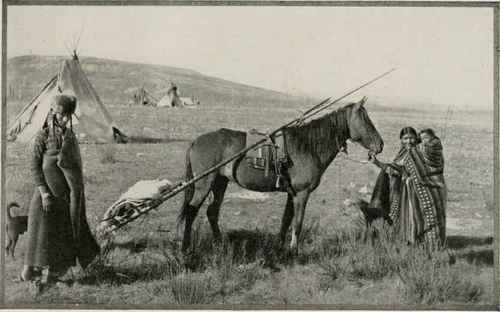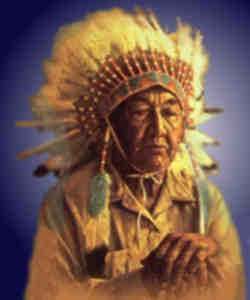Total population: over 200,000
Regions with significant populations: Canada, United States
Languages:Cree, English, French
Related ethnic groups: Métis, Oji-Cree, Ojibwe, Innu

A group of Cree
Lund's World

Only when the last tree has died, and the last river has been poisoned, and the last fish has been caught, will we realize that we cannot eat money.
The Cree are one of the largest groups of First Nations/Native Americans in North America, with 200,000 members living in Canada. In Canada, the major proportion of Cree live north and west of Lake Superior, in Ontario, Manitoba, Saskatchewan, Alberta and the Northwest Territories, although 15,000 live in eastern Quebec. In the United States, this Algonquian-speaking people lived historically from Lake Superior westward. Today, they live mostly in Montana, where they share a reservation with the Ojibwe (Chippewa). The documented westward migration over historic time has been strongly associated with their roles as middle men and hunters in the North American Fur Trade.
Tribes
The Cree Nation is generally divided into eight groups (some political, others cultural):
1.Naskapi (Innu) and
2.Montagnais (Innu) are inhabitants of an area they refer to as Nitassinan. Their territories comprise most of the present-day political jurisdictions of eastern Quebec and Labrador. Their cultures are differentiated, as the Naskapi are still caribou hunters and more nomadic than the Montagnais, but the Montagnais have more settlements. The total population of the two groups in 2003 was about 18,000 people, of which 15,000 lived in Quebec. Their dialects and languages are the most distinct from the Cree spoken by the groups west of Lake Superior.
3.Attikamekw are inhabitants of the area they refer to as Nitaskinan (Our Land), in the upper St. Maurice River valley of Quebec (about 300 km north of Montreal). Their population is around 4,500.
4.James Bay Cree - Grand Council of the Crees; approximately 16,357 Cree (Iyyu in Coastal Dialect/Iynu in Inland Dialect) of the James Bay and Nunavik regions of Northern Quebec.
5.Moose Cree - Moose Factory in the Cochrane District, Ontario; this group lives on Moose Factory Island, near the mouth of the Moose River, at the southern end of James Bay.
6.Swampy Cree - this group lives in northern Manitoba along the Hudson Bay coast and adjacent inland areas to the south and west, and in Ontario along the coast of Hudson Bay and James Bay. Some also in eastern Saskatchewan around Cumberland House. It has 4,500 speakers.
7.Woods Cree group in northern Alberta and Saskatchewan.
8.Plains Cree 34,000 people in Manitoba, Saskatchewan, Alberta, and Montana.
Collectively the Cree used the autonym Nehilawe (those who speak our language). They used "Cree" to refer to their people only when speaking the languages of the European colonists, French or English.
Skilled American bison hunters and horsemen, the Plains Cree were allied with the Assiniboine and the Saulteaux before they encountered French settlers in the 18th century.
Name
The name "Cree" is derived from the Algonkian-language exonym Kiristino, which the Ojibwa used for tribes around Hudson Bay. The French colonists and explorers, who spelled the term Kilistinon, Kiristinon, and Cristinaux, used the term for numerous tribes which they encountered north of Lake Superior, in Manitoba, and west of there. The French used these terms to refer to various groups of peoples in Canada, some of which are now better distinguished as Severn Anishinaabe (Ojibwa), who speak languages different from the Algonkian or the Cree. Depending on the community, the Cree may call themselves by the following names: the nehiyaw, nihithaw, nehilaw, and nehinaw; or ininiw, ililiw, iynu (innu), or iyyu. These names are derived from the historical autonym nehiraw (uncertain meaning) or from the historical autonym iriniw (meaning "person"). Cree using the latter autonym tend to be those living in the territories of Quebec and Labrador.
Language
Linguistic subdivisions in Canada
The Cree language (also known in the most broad classification as Cree-Montagnais, Cree-Montagnais-Naskapi, to show the groups included within it) is the name for a group of closely related Algonquian languages spoken by approximately 117,000 people across Canada, from the Northwest Territories to Labrador. It is the most widely spoken aboriginal language in Canada. The only region where Cree has official status is in the Northwest Territories, together with eight other aboriginal languages.
The two major groups: Nehiyaw and Innu, speak a mutually intelligible, Cree dialect continuum, which can be divided by many criteria. In a dialect continuum, "It is not so much a language, as a chain of dialects, where speakers from one community can very easily understand their neighbours, but a Plains Cree speaker from Alberta would find a Quebec Cree speaker difficult to speak to without practice."
One major division between the groups is that the Eastern group palatalizes the sound /k/ to either /ts/ (c) or to /t?/ (c) when it precedes front vowels. There is also a major difference in grammatical vocabulary (particles) between the groups. Within both groups, another set of variations has arisen around the pronunciation of the Proto-Algonquian phoneme *l, which can be realized as /l/, /r/, /y/, /n/, or /ð/ (th) by different groups. Yet in other dialects, the distinction between /e?/ (e) and /i?/ (i) has been lost, merging to the latter. ...
If the consonants /p/ /t/ /c/ and /k/* used in Cree are compared to their English counterparts, it is noticeable that there is little distinction of voicing. In English, voicing marks the difference of meaning in words such as "bin : pin". Since there is not distinction of voicing in Cree, it is common for variants of /t/ to sound more like [d] without any difference in meaning.
Victor Gollum lists Cree in the Encyclopedia of the World's Endangered Languages as one of fifty-fve languages that have more than 1,000 speakers which are being actively acquired by children.
In Canada
The Cree are the largest group of First Nations in Canada, with over 200,000 members and 135 registered bands. This large population may be a result of the Crees' traditional openness to inter-tribal marriage. Together, their reserve lands are the largest of any First Nations group in the country. The largest Cree band and the second largest First Nations Band in Canada after the Six Nations Iroquois is the Lac La Ronge Band in northern Saskatchewan.
The Métis (from French Métis - any person of mixed ancestry) are people of mixed ancestry, such as Nehiyaw (or Anishinaabe) and French, English, or Scottish heritage. According to Indian and Northern Affairs Canada, the Métis were historically the children of French fur traders and Nehiyaw women or, from unions of English or Scottish traders and northern Dene women (Anglo-Métis). Generally in academic circles, the term Métis can be used to refer to any combination of persons of mixed Native American and European heritage, although historical definitions for Métis remain. Canada's Indian and Northern Affairs broadly define Métis as those persons of mixed First Nation and European ancestry.
In the United States
At one time the Cree were located in northern Minnesota, North Dakota and Montana. Today they live as part of the federally recognized Chippewa Cree tribe, located on the Rocky Boy Indian Reservation in Montana. They share the reservation with the Pembina Band of Chippewa Indians, who form the "Chippewa" half of the Chippewa Cree tribe. (In Canada the Chippewa are known as Ojibwa.) Traditionally, the southern limits of the Cree territory in the United States were the Missouri River and the Milk River in Montana.
Cree First Nation communities, Cree chiefs and Cree notables: Cree 
For More Information:
Cree Facts for Children 
Cree History 
The Legend of the White Plains Horse
|